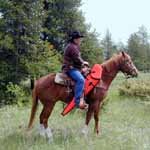
We recently heard from Bernice as she was trying to pass through Red Cloud, Nebraska. Red Cloud is described as an American classic, a typical small town in the heartland. Red Cloud is a small, vibrant community nestled in the Lower Republican River Valley, neatly self-contained by pastures and cornfields. Here, Bernice describes her longer-than-expected visit.
9/20/06
How did this happen? I rode into town an innocent horse rider, and I am now judging a chili cook off in a couple of days! So much fun!! This is the Red Cloud Chamber of Commerce’ Third Annual September Fest Chili and BBQ Cook-off. It will be held September 23 at the Red Cloud City Park. There are categories for Chili, Beef, Pork, “Other” and (yea!) Desserts.
I just spoke at the Senior Center for a “pass the hat” talk – I walked away with $10 AND lunch. I seem to be doing more and more speaking to pick up a few dollars here and there.
Red Cloud - Home of famous writers like Willa Cather. It is a “Historical Town”, with brick streets. Kind of a bookish/literary kind of town I did not expect to find way out here; so far from anything, really.
More later...



